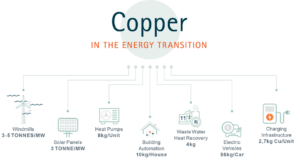The European Copper Institute welcomes the publication of the “Fit for 55” package of proposals by the European Commission today.
An ambitious and balanced legislative framework is needed to create the conditions that will allow European businesses, industries and consumers to accelerate the transition toward carbon neutrality in the run up to 2030.
The copper industry has a significant role to play in enabling the transition to Net Zero. Thanks to its excellent electrical and thermal conductivity, as well as other properties, copper is used across the electricity system and for heat exchange, including applications such as windmills, power grids, solar panels, electric vehicles, charging infrastructure, building automation, energy storage, solar thermal, wastewater heat recovery, heat pumps and batteries. Overall, copper-enabled decarbonising technologies can abate approximately 75 percent of the EU GHG emissions1. Copper also contributes to resource efficiency as a carrier metal, facilitating the recovery of many other valuable metals needed for the energy transition such as silver, gold, platinum and palladium. Copper, therefore, plays a crucial role in the transition to a climate-neutral, resilient European economy.

The revision of the EU climate and energy legislative framework under the package adopted today should:
- Drive energy efficiency further in sectors with vast untapped potential for cost-effective improvements, such as road transport, heating and cooling, and incentivize the uptake of system-level energy saving applications such as electric motor systems, electrical installations in buildings and building automation
- Accelerate the deployment of renewables, while keeping energy prices affordable for consumers, for instance by providing guidance to Member States to address electricity charges and levies
- Facilitate electrification to increase the penetration of renewables in heating and cooling
- Introduce ambitious measures to strengthen CO2 standards for cars and vans and to promote the roll out of charging infrastructure, in order to accelerate the electrification of road transport
The ‘Fit for 55’ proposals must also support the European copper industry in the transition towards carbon neutrality, to ensure the industry can continue to provide secure access to the raw materials needed for decarbonisation. To support the ability of Europe’s energy intensive industries to invest in decarbonisation, the ‘Fit for 55’ package should provide:
- Long-term predictability and certainty of the regulatory framework
- Stable access to low-carbon energy sources at competitive prices
- Robust protection against carbon leakage under the revised ETS and the Climate, Energy and Environmental Aid Guidelines
- Financial support for industry decarbonization and low-carbon technologies to promote energy efficiency, emissions reduction, and the development and deployment of innovative production processes
The revision of the Energy Performance of Buildings Directive to be proposed later this year should be aligned with the “Fit for 55” ambition presented today to secure the contribution of building stock to the 2030 targets. As acknowledged by the Renovation Wave strategy, a significant boost in renovation rate and depth is needed to drive energy efficiency, renewables and electrification in buildings.
Bernard Respaut, Chief Executive of the European Copper Institute said:
“The European copper industry is committed to contributing to the clean energy transition in Europe by ensuring a sustainable and circular supply of copper to enable the technologies needed for decarbonisation. To meet this challenge, we need a legislative framework that balances ambition with support for Europe’s energy intensive industries in their efforts to decarbonise.”
THE EUROPEAN COPPER INSTITUTE LOOKS FORWARD TO engaging with the EU institutions and other stakeholders in the months ahead on this important package of proposals.
[1]Copper estimate based on the EU 2050 “High-RES” scenario, of the EU 2050 energy roadmap, plus additional assumptions about the uptake of emerging technologies. https://ec.europa.eu/energy/sites/ener/files/documents/2012_energy_roadmap_2050_en_0.pdf
GHG estimate based on DecarbEurope. https://decarbeurope.org/
